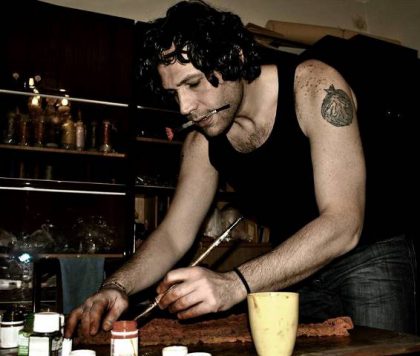
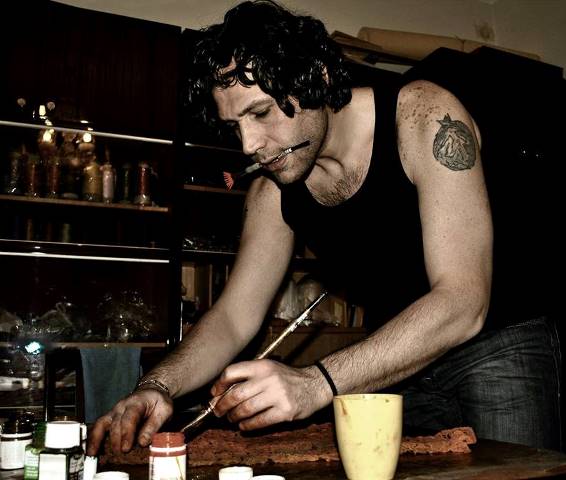
Meri Martirosyan
Azad-Hye
Kevork Shadoyan was born and raised in Aleppo, Syria in true Armenian spirit. His family has kept alive the native Armenian language, the traditions and the Armenian cuisine. Kevork remembers how they used to paint the Easter eggs with the tricolor of the Armenian flag.
He first arrived in Armenia in 2001, planning to examine the Armenian costumes and decorative motifs. Soon he was enrolled as student in the State Academy of Fine Arts. Now he continues to be there as instructor-lecturer, trying to convey his knowledge and experience to the students.
Shadoyan remained in Armenia until 2009, when he decided to returned back to Syria and open a fashion school. The events in Syria in 2011 obliged him however to reconsider his decision. So he returned back, opened his fashion gallery and settled down permanently in Yerevan.
Shadoyan initiated the creation of series of costumes using Armenian national characteristics. He occupies a unique position in Armenia and prefers the free athletic and casual styles.
Azad-Hye interviewed Shadoyan in Yerevan:
-Kevork, how did you take the decision for entering the world of fashion design? Was it a coincidence?
My father was a tailor. I used to watch him at work, trying to do some experiments myself. Gradually I realized that men's costume designs did not attract me. I though the existing forms were somehow limited and there was no space for creativity. This motivated me to start designing for women.
-What kind of material and colors you would prefer using in your work?
Most of all I prefer silk and other smooth material. I use very much the color of the pomegranate in my works. I have adopted it as my symbol. It captures the colors of fire. Generally speaking, I like almost all colors.
-Are you satisfied with the number of clients you have now?
It is hard to say, because I do not only sell costumes in Armenia, in fact I travel a lot and produce clothes for people from various nationalities. I remember providing designs to costumes for the dowry of a princesses in an Arab country.
-Let us refer also to clothes designed for children.
My children clothes are exclusively with Armenian characteristics. I am more focused on baptism design but now I am doing also other designs.
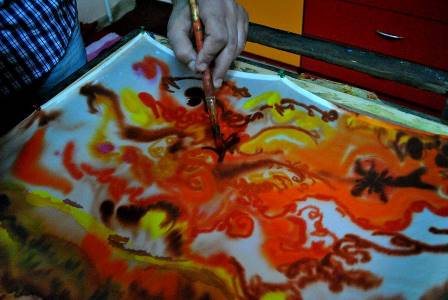 -To whom your work is addressed? Is it accessible to everyone?
-To whom your work is addressed? Is it accessible to everyone?
Anyone can get my designs. The value of a design is determined by the time spent on it and the effort made in creating it. I never use low quality material in my work. This has also an influence on determining the value of the dress.
-Do you accept all requests? In other words, do you reject any request?
Whoever approaches me already knows my style and the works that I design. Usually I am not asked to design items far from my general style. I mainly design evening and wedding dresses, but of course I accept other orders as well.
-Are there any principles that you adhere to and try not to violate at work?
I have always been against imitations? It is true that I do not force my style on my clients but I am known to have a unique style. I had appeared in exhibitions in many countries including USA, Turkey, Australia, Ukraine, etc. I would like to point out that in Turkey I have presented designs with Armenian national symbols, including a dress with our national flag?s tricolor, carrying the name ?Armenia? on it, with a cross on the waist. I believe we need to create our own designs and avoid imitating international ones.
-What can you say about the prevailing fashion styles in Armenia?
I believe nowadays people are more elegant in their choices, compared to what it was several years ago. It is obvious however that they are not always successful in harmonizing the clothes with the locations. Also they sometimes fail in coordinating between the colors. The problem is that the number of designers are limited in Armenia and there are no fashion weeks that would influence public taste.
Advice by Kevork Shadoyan:
-If you are wearing a normal blue jeans with light sweater, do not use classic leather shoes, rather use more casual and sportive shoes.
-If you are overweight, do not wear tight clothes that would emphasize your body shape, rather wear light and loose ones.
-If you have dark skin, hair and eyes, it is not a good idea to wear black clothes, though white clothes would not fit either. In such cases try light brown clothes.
-Your trousers and sweater might fit in terms of colors and style, but they might not be compatible with your skin color. Take this into consideration when selecting your clothes.
For more information you can visit the website www.shadoyan.com, where you will be introduced to Kevork Shadoyan?s world, activities, achievements and latest design samples.
TEXT IN ARMENIAN
Գևորգ Շադոյան`?Դեմ եմ կրկնօրինակումներին?
Մերի Մարտիրոսյան
Ազատ-Հայ
Հալեպում ծնված և հայկական ոգով դաստիարակված Գևորգ Շադոյանը վերջին տարիներին ապրում է Հայաստանում: Ծնողները երկուսն էլ հայ են: Ընտանիքում մշտապես պահել են մայրենի լեզուն, ավանդույթները, հայկական խոհանոցը:
Գևորգը հիշում է`Սուրբ Զատկի տոնին հավկիթները ներկում էին հայկական դրոշի գույներով: Դիզայներն առաջին անգամ Հայաստանում է եղել 2001 թվականին: Եկել էր ուսումնասիրելու հայկական տարազներն ու զարդանախշերը:
Այդ ժամանակ ընդունվում է Գեղարվեստի պետական ակադեմիա: Հիմա այնտեղ ներկայանում է ոչ թե որպես ուսանող, այլ արդեն դասախոս`փորձն ու գիտելիքները փոխանցելով նորաթուխ ուսանողներին:
Մինչեւ 2009-ը մնացել է Հայաստանում, հետո մեկնել Սիրիա: Այնտեղի նորաբաց նորաձեւության դպրոցում կազմակերպչական հարցերով է զբաղվել, նաեւ`դասավանդել: Սակայն 2011-ին կրկին վերադարձել է Հայաստան, բացել իր արվեստանոցն ու վերջնականապես հաստատվել այստեղ:
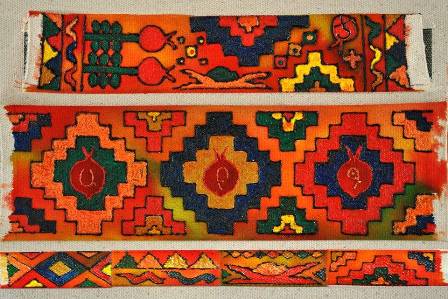 Դիզայները ձեռնամուխ է եղել նոր, հետաքրքիր ու ազգային ոգուն մոտ զգեստների ստեղծմանը: Հիմա Գևորգ Շադոյան անունը Հայաստանում արդեն իր ուրույն տեղն ունի: Փորձառություն է ձեռք բերել Դուբայում, Սիրիայում, Սաուդյան Արաբիայում: Դիզայներն անձամբ նախընտրում է ազատ, սպորտային ոճը:
Դիզայները ձեռնամուխ է եղել նոր, հետաքրքիր ու ազգային ոգուն մոտ զգեստների ստեղծմանը: Հիմա Գևորգ Շադոյան անունը Հայաստանում արդեն իր ուրույն տեղն ունի: Փորձառություն է ձեռք բերել Դուբայում, Սիրիայում, Սաուդյան Արաբիայում: Դիզայներն անձամբ նախընտրում է ազատ, սպորտային ոճը:
-Գևորգ, ինքներդ որոշեցիք զբաղվել հագուստի դիզայնով, թե՞ դա պատահաբար ստացվեց:
Հայրս դերձակ է եւ երբ փոքր էի, մշտապես հետեւում էի նրա աշխատանքին, ինքս էլ փորձեր անում: Սակայն աստիճանաբար հասկացա, որ տղամարդու հագուստի ստեղծումն ինձ այնքան էլ չի գրավում, քանի որ ձեւերը սահմանափակ են եւ ստեղծագործելու տեղ գրեթե չկա: Այդպես սկսեցի կանանց համար հագուստ ստեղծել:
-Ի՞նչ կտորներով եւ գույներով եք նախընտրում աշխատել:
Ավելի շատ նախընտրում եմ մետաքսը, նուրբ, կանացի կտորները: Նռան գույնն եմ շատ օգտագործում, որը որպես դիզայներ`իմ խորհրդանիշն է, կրակի գույները, իսկ ընդհանրապես`բոլոր գույներն էլ սիրում եմ:
-Հաճախորդների քանակն արդյո՞ք գոհացնում է Ձեզ:
Դժվար է ասել, քանի որ ես միայն Հայաստանում չէ որ հագուստ եմ վաճառում, այլ շատ եմ ճամփորդում եւ հագուստներ կարում տարբեր ազգի ներկայացուցիչների համար: Օրինակ արաբական երկրներում. որոշ ժամանակ առաջ իշխանուհիների համար մի ամբողջ օժիտի հագուստ եմ կարել:
-Խոսենք նաեւ երեխաների համար ստեղծվող հագուստներից:
Երեխաների հագուստը բացառապես հայկական պետք է լինի. զարդանախշերով, գոգնոցներով եւ այլ պարագաներով: Ես արդեն ստեղծել եմ մկրտության համար հագուստներ, շուտով կլինեն նաեւ այլ գործեր:
-Կա՞ կոնկրետ մի խավ, որի համար եւ ստեղծվում են Ձեր հագուստները, թե դրանք հասանելի են բոլորին:
Իմ հագուստներից կարող են ձեռք բերել տարբեր խավի մարդիկ: Նայած, թե ինչքա՞ն եմ աշխատել տվյալ հագուստի վրա, ի՞նչ ձեռքի աշխատանք է կատարվել, ըստ դրա էլ որոշվում է հագուստի արժեքը: Ոչ մի դեպքում չեմ օգտագործում անորակ կտոր, դա էլ պետք է հաշվի առնել:
-Ցանկացած պատվեր ընդունո՞ւմ եք, թե լինում են բացառություններ, որ հրաժարվում եք տվյալ տեսակի հագուստ կարել:
Ինձ մոտ եկողն արդեն գիտի իմ ոճը, իմ արած աշխատանքները եւ սովորաբար չեն պատվիրում այնպիսի հագուստ, որն իմ ձեռագրին մոտ չլինի: Հիմնականում երեկոյան եւ հարսանյաց ոճի հագուստ եմ կարում, բայց իհարկե, ընդունում եմ նաեւ այլ ոճի հագուստի պատվերներ:
-Կան սկզբունքներ, որոնք երբեւէ չեք խախտում`աշխատանքի ժամանակ:
Ես միշտ դեմ եմ կրկնօրինակմանը? Ճիշտ է`չեմ պարտադրում իմ ոճը, կարող եմ տարբեր պատվերներ կատարել, բայց ինձ հենց դրանով են ճանաչում, որ հագուստի մեջ ես իմ ոճն ունեմ: Աշխատում եմ Հայաստանում ու եւս 15 երկրում: Օրինակ ԱՄՆ-ում Թուրքիայում, Ավստրալիայում, Ոկրաինայում եւ այլուր ցուցադրություն եմ ունեցել: Ուզում եմ նշել, որ Թուրքիայում ներկայացրել էի կրկին ազգային շեշտադրմամբ հագուստներ, որոնցից մեկը եռագույն դրոշի գույներով էր, մեջտեղում գրված էր Արմենիա, մեջքին էլ`խաչքար կար: Այսինքն`պետք է քոնը ստեղծես, ոչ թե նայես, թե համաշխարհային դիզայներներից ով ինչ է կարել, դա նույն ձեւով կրկնես:
-Առավել հաճախ ի՞նչ սխալներ եք նկատում մեզ մոտ`կապված հագուստի հետ:
Կարծում եմ`հիմա առավել ճաշակով են հագնվում, քան տարիներ առաջ: Միայն այն է սխալ, որ հաճախ չեն կարողանում տվյալ տեղին համապատասխան հագուստ կրել, նաեւ`ճիշտ չեն համադրում գույները: Խնդիրը նրանում է, որ դիզայներները քիչ են, նորաձեւության շաբաթներ չկան, որ թելադրեն, թե ինչպես կարելի է ճիշտ հագնվել:
Եվ վերջում մի քանի խորհուրդ դիզայներից.
-Եթե դուք սովորական, կապույտ ջինս եք հագնում որեւէ թեթեւ բլուզով, դրանց հետ ոչ թե խիստ դասական, կաշվե կոշիկ կրեք, այլ սպորտայինին մոտ:
-Եթե գեր եք, մեծ փոր ունեք, ապա ճիշտ չէ կրել կիպ հագուստ, որն ավելի կընդգծի այդ գիրությունը, այլ հակառակը`ավելի թեթեւ, ազատ հագուստ:
-Եթե մաշկը, մազերը եւ աչքերը մուգ են, ապա չարժե սեւ հագուստ կրել, բայց սպիտակն էլ ճիշտ չէ: Այս դեպքում կարելի է բաց շագանակագույն հագնել:
-Կարող են տաբատը եւ բլուզը շատ սազել իրար հետ գույնի եւ ոճի առումով, բայց մաշկի գույնը չսազի: Հաշվի առեք նաեւ այս հանգամանքը:
Բոլոր հետաքրքրվողները կարող են այցելել www.shadoyan.com էջ եւ ծանոթանալ դիզայների ամբողջ գործունեությանը եւ հագուստներին
Photo: With Meri Martirosyan
|
|

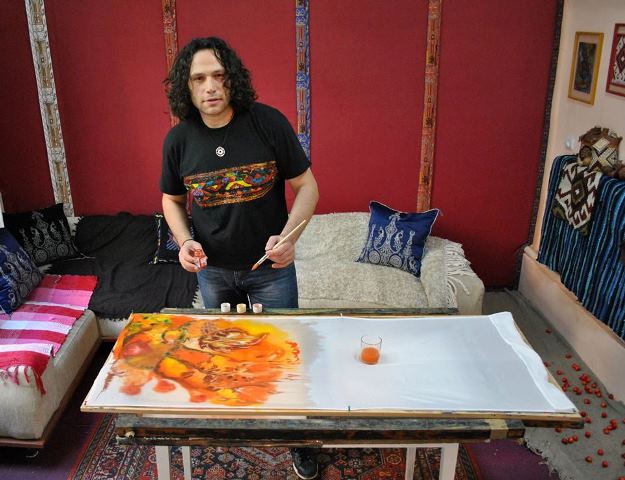
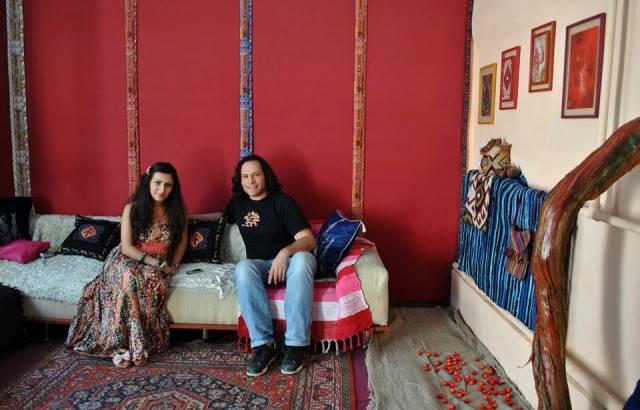
Shad taghandavor mard.bravo